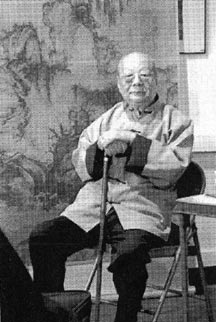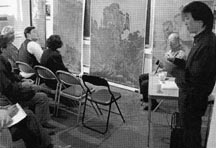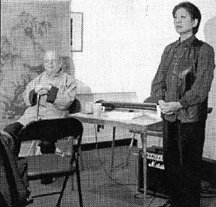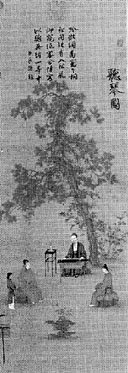| |
 Main Menu
Main Menu
選 項
Year 2000
Year 2001
Year 2002
Year 2003
| |
C.C. WANG DISCUSSES THE ART OF PAINTING
Date: 25 September 2000
Time: 2:00-4:30PM
Place: China Institute, 125 65th Street, New York City
Minutes: Matthew Flannery
Member Attending:
Stephen Dydo, Willow Hai Chang, Matthew Flannery, Shida Kuo, Yuan Jung-Ping
Events:
Alan has published an account of the
practice and role of retreat among the literati
aristocracy through the sixth century.
The particulars: Alan J. Berkowitz Patterns of Disengagement: The Practice and
Portrayal of Reclusion in Early Medieval China
Stanford: Stanford University Press, 2000 296 pp., hardbound, $55.00 ISBN: 0-8047-3603.0
The book concerns the rationale, practice, and
portrayal of reclusion in China from the earliest
times through the sixth century, by which time
reclusion largely acquired its enduring character.
Essentially, the touchstone of the man in reclusion was
conduct and personal integrity that was manifested in
the unflinching eschewal of official position. It was his
outsider's stance that constituted the cause for public
acclaim of the recluse: men in reclusion forwent
opportunities for worldly success and a role in the
central government, but they did not surrender their
integrity nor compromise their resolve, mettle, or moral
and personal values in the face of adversity, threat, or
temptation. The book treats the practice of reclusion
and individual practitioners within the social, political,
intellectual, religious, and literary contexts of the times.
It also treats the topos ubiquitous in Chinese culture of
" the recluse, " who classically resided quiet and
unperturbed in his rustic dwelling amid a benign
wilderness.
Alan notes that little is said in his work of the
artistic, including musical, aspects of the recluse, and
adds that " I must make up for this great lapse in the
future.
The Meeting: C. C. Wang Discusses the
Art of Painting

|
|
Mr. C.C. Wang discusses the art of painting at the China Institute.
|
It centered on a discussion of Chinese painting by
Wang Ch'i-ch'ien 王己千(C. C. Wang). Mr. Wang is
equally noted for excelling in three fields related to
painting. He is a connoisseur of early painting
(especially, the Tang through Yuan periods, 960-1368),
a collector of paintings
from many periods, and a
landscape painter who
excels both at traditional
brushwork and at
extending that tradition
into new arenas. Beyond
painting, his calligraphy
is also sought and
collected.
In painting, he is
especially known for
basing the brushwork of
traditional landscape
painting on aleatoric
elements created by pretreating the paper. For
example, sometimes he impresses papers with inked
planks to create wood patterns, or he crumples them
into balls and dips their projecting angles into pooled
ink. The resulting lines, blots, and patterns are then
converted into landscapes by adding traditional
elements trees, huts, rocks, varieties of landscape
texture strokes in ink or color. To color such broad
areas as mountains and rivers or add sunsets, he usually
adds washes of light color.

|
|
Jung-Ping and Mr. C.C. Wang at the China Institute.
|
Mr, Wang, with occasional interpretation assistance
from his daughter Wang Xiange王嫻歌, began by
saying that an artist is not an expert on the academics of
painting but perhaps may contribute some idea of what
painting is about. After 50 or 60 years in the art, he has
learned that the viewpoint of those who do and do not
know about painting is slightly different. He noted that,
while the Qin Society is about music, painting is
nothing other than visual music.
The purpose of painting in its formative years was
to reproduce reality. This was generally true in east and
west: the formative steps of painting are to bring real
forms under the control of artistic tools. In the west,
however, reality long remained the principle criterion
by which the quality and social acceptability of painting
was judged. The aim was to capture the essence of a
thing by portraying its outward form as exactly as
possible. Even in the east, this was true of some
schools of painting, such as the academic or courtly
style that flourished under Hui-tsung 徽宗 (r. 1101-
1126) of the Northern Sung (960-1126). But in other
schools of eastern painting, there was less interest in
literal realism.

|
|
Fan Kuan 范寬(early eleventh century), Quo XI 郭熙(late eleventh century), and Li Tang 李唐(early twelfth century)
豀山行旅圖 Traveling among mountains and streams" 早春圖 "Early Spring" 萬壑松風圖 "Pine Winds in Ten Thousand Valleys"
|
Even as eastern art also strove for realism, it
modified this trend by the appreciation of calligraphy
and music for the abstract line, and, even as painting
remained fundamentally based in realism, abstraction
became one of its important values. Eastern painting,
he noted, was like opera: its sets, shallow acting space,
and distinctive singing style were suggestive of reality
without replicating it exactly, while western painting
was more like drama, with its often more realistic sets
and spoken lines. While east and west began from the
viewpoint of realism, by the Northern Sung, the
abstraction of calligraphy becomes observable in
eastern painting, whereas western painting did not
begin to investigate this approach until the nineteenth
century.
Eastern figure painting before the Tang did not
reach the technical perfection eventually achieved in
the classical ancient west, but the linear, calligraphic
expression of its linework was sufficient to capture
emotional expression of a figure. With line important,
so the brush was important. East and west, brushes and
strokework were different. In eastern painting,
brushwork became the criterion for judging the quality
of a painting, for distinguishing between good and bad
painting as well as authentic and inauthentic paintings.
If one can distinguish the type and style of brushwork,
one can determine the authenticity of a painting based
on its brushwork. Western paintings are more heavily
worked over, with paint added in layers, which makes
the brushwork more difficult to analyze. In eastern
painting, where strokes are laid down individually with
little correction or overpainting, strokes stand clear
before the connoisseur's eye, making it relatively easy
to authenticate a painting.

|
|
Ni Can, 倪瓚(1301 -1374)
The Rung Xi Studio 容膝齋(1372)
|
Mr. Wang said he is frequently approached by
westerners regarding his opinion of the authenticity of a
painting. Still, they wonder how he can authenticate a
painting while they cannot and tend to lose confidence
in his judgment. The key is that one must do painting
to understand it. Looking at a painting is like going to
the opera: one must listen to the vocal quality, not just
the storyline. That is how anyone can tell, just from a
" Hello, " who is speaking if they know that person
well. And if faking a single "hello " is easy, it is
much harder to fake an entire conversation or a
painting.
Chinese art theory is that great artists have greater
characters, and hence they have the more distinctive
styles. Ni Can's 倪瓚(1301-1374) work, for example,
is so simple, yet it says everything. A rock, a tree, and
a hut are all that is needed to express one's ideas,
emotions, talent. A painting is a reflection of an artist:
it sings his song. If his work looks too much like that
of others, then the individual is not a great artist.
Hence, Mr. Wang concluded, it is this distinctiveness,
especially among great artists, that allows their work to
be judged and authenticated by connoisseurs.

|
|
Mr. Wang replied that musical sounds can describe a
brook or a bird, as can the brushstrokes of a painting......
Wang Xiange (right)
|
Those attending had some questions. Stephen
noted that painting, like calligraphy, includes a time
element in the process of painting, the path of the
brush. Is this what Mr. Wang meant by the relationship
between music and painting? Mr. Wang replied that
musical sounds can describe a brook or a bird, as can
the brushstrokes of a painting. But the abstract
qualities of music are like those of painting, and these
are the heart of the matter. A bird and a brook, a rock
and a tree do not mean anything:
they are the vehicle for the
abstract expression of the
brushwork. An artist does not
describe a mountain. He
describes its beauty and spirit.
Western abstraction is so obvious
that it is easily seen, but in the
east it is harder to detect it hides
behind the things it describes, just
as, in calligraphy, the brushwork
hides behind a calligraphy's
literary message, which tends to
distract its viewers from its
graphic qualities. But it is
precisely in the abstract quality of
the brushwork that the essence
and value of painting and
calligraphy reside.

|
|
Hui-tsung 徽宗(r. 1101-1126) "Listening to the Qin."聽琴圖
|
Jung-Ping asked whether the
three scrolls that Mr. Wang had
had hung across the wall of the
room represented different
schools of painting. Mr. Wang
replied that all three were
reproductions of Northern Sung
paintings by different artists and
did so much not represent
different schools as the different personal styles of their
three artists, styles that eventually became models for
later artists. The three artists represented. Fan Kuan 范寬(early eleventh century), Guo Xi 郭熙(late eleventh
century), and Li Tang 李唐(early twelfth century), all
used variations in brushwork to express their various
personalities. Hence, all three scrolls show painted
mountains with their own personalities, mountains that
look neither real nor like each other.

|
|
Stephen played "Ping Sha Lo Yen" ("Wild Geese Descending to Sandy Shores").
|
Qin Performance:
After Mr. Wang's talk, Stephen played "Ping
Shao Lo Yan" 平沙落雁( "Wild Geese
Descending to Sandy Shores"). "Ping
Shao Lo Yan" is extant in more than 30 variants which
usually have five, seven, or ten sections. Its earliest
score is found in the qin manual Gu Yin Zheng Zong
古音正宗(1634).
Jung-Ping then played two pieces, "Mei Hua San
Nung" 梅花三弄(" Three Variations on the Plum
Blossoms o") and "Pu 'an Zho" 普庵咒("Chant of
Pu'an"). Of the two themes in "Mei Hua San
Nung," the first is repeated three times in successively
higher registers; hence the title. Said to date in its
original form from the Qin and Sui dynasties, it was
arranged for qin in the Tang by Yan Shigu 顏師古.
"Pu'an Zho" is first found in the San Jiao Tong Sheng
Pu 三教同聲 of 1592. It purports to record a chant by
Pu'an, a Buddhist monk.
Members: Alex Chao, Stephen Dydo, Matthew Flannery, Willow Hai, Shida Kuo, Bo Lawergren, Gopal Sukhu, Yuan Jung-Ping
|

